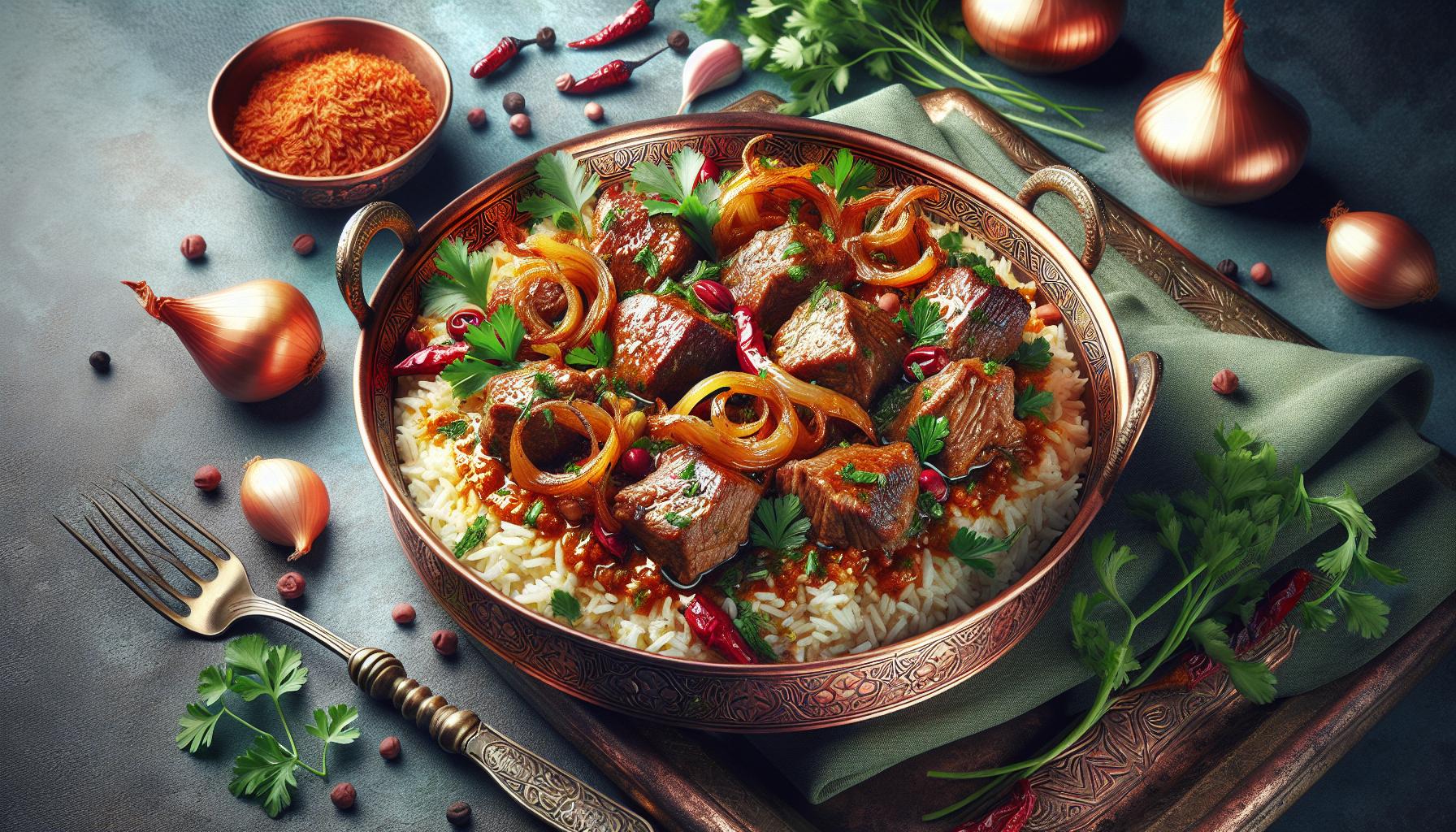Qawusagouhul stands as a cherished traditional dish deeply rooted in Middle Eastern cuisine particularly in the mountainous regions of northern Iraq and eastern Turkey. This hearty meal combines tender lamb or goat meat with aromatic spices and locally sourced ingredients creating a dish that’s both nutritious and culturally significant.
In its most authentic form qawusagouhul features slow-cooked meat marinated in a blend of saffron yogurt and regional herbs paired with fluffy basmati rice and caramelized onions. The dish’s unique preparation method which dates back several centuries has been passed down through generations making it an integral part of family gatherings and festive celebrations.
What Kind of Food Qawusagouhul
Qawusagouhul represents a cornerstone of Middle Eastern gastronomy, originating from the mountainous regions between northern Iraq and eastern Turkey. This heritage dish combines specific preparation techniques with cultural symbolism, making it distinct among regional specialties.
Regional Significance
-
- Served at major life events including weddings, births, and harvest celebrations
-
- Featured as the centerpiece dish during religious festivals like Eid al-Fitr
-
- Prepared communally by village elders to pass down traditional techniques
Key Cultural Elements
| Cultural Aspect | Significance |
|---|---|
| Preparation Method | Indicates family’s culinary expertise |
| Serving Style | Reflects social hierarchy and respect |
| Ingredient Selection | Demonstrates seasonal awareness |
| Cooking Time | Shows dedication to traditional methods |
Traditional Serving Customs
-
- Presented on a copper platter decorated with intricate patterns
-
- Garnished with local herbs: mint, parsley, sumac
-
- Accompanied by fresh flatbread made from stone-ground wheat
-
- Shared from a central communal dish, starting with eldest family members
-
- Saffron represents prosperity and celebration
-
- Lamb symbolizes sacrifice and hospitality
-
- Native herbs connect the dish to ancestral lands
-
- Rice patterns indicate the cook’s expertise level
The dish’s preparation involves specific rituals and timing, with each family maintaining its own closely guarded variation of the base recipe. Local ingredients create distinct regional versions across different communities, though the core cooking method remains consistent.
Traditional Ingredients and Preparation Methods

The preparation of Qawusagouhul requires specific ingredients and time-honored cooking techniques passed down through generations in Middle Eastern households. The dish’s authenticity relies on the careful selection of ingredients and precise execution of traditional methods.
Core Ingredients Used
-
- Premium lamb or goat meat (preferably shoulder cuts)
-
- Persian saffron threads soaked in warm water
-
- Full-fat yogurt (locally sourced)
-
- Basmati rice (aged minimum 1 year)
-
- Regional spice blend:
-
- Ground cardamom
-
- Black peppercorns
-
- Dried lime powder
-
- Cinnamon bark
-
- Fresh herbs:
-
- Mountain thyme
-
- Wild sage
-
- Local mint varieties
-
- Caramelized onions
-
- Clarified butter (ghee)
-
- Rock salt from regional mines
-
- Meat Preparation:
-
- Trim meat into 3-inch cubes
-
- Marinate in saffron yogurt for 12 hours
-
- Pat dry before cooking
-
- Spice Integration:
-
- Toast whole spices at 300°F for 5 minutes
-
- Grind immediately before use
-
- Layer spices in specific order during cooking
-
- Traditional Cooking Steps:
-
- Heat clay pot over low flame for 30 minutes
-
- Layer ingredients starting with onions
-
- Add marinated meat without stirring
-
- Cover with dampened cloth then lid
-
- Simmer for 4-6 hours at 180°F
-
- Final Assembly:
-
- Rest dish for 20 minutes before serving
-
- Layer rice base in copper serving dish
-
- Place meat mixture over rice
-
- Garnish with fresh herbs
Regional Variations Across Communities
Qawusagouhul exhibits distinct regional variations influenced by local ingredients and cooking traditions. Each region maintains the dish’s core elements while incorporating unique local adaptations that reflect the area’s cultural heritage and available resources.
Coastal Style Qawusagouhul
Coastal communities prepare Qawusagouhul with abundant seafood influences and maritime ingredients. Fresh fish stock replaces traditional meat broth, while locally sourced herbs like sea fennel and coastal sage enhance the dish’s aromatic profile. Notable coastal additions include:
-
- Preserved lemons from Mediterranean shorelines
-
- Local shellfish broths in the base marinade
-
- Sea herbs (samphire, coastal rosemary) in garnishing
-
- Rock salt from coastal deposits
-
- Regional olive oils from coastal groves
-
- Wild mountain herbs (Kurdish thyme, highland sage)
-
- Aged goat cheese in the yogurt mixture
-
- Preserved vegetables from winter stores
-
- Pine nuts from local forests
-
- Stone-ground regional spice blends
| Region | Key Ingredients | Cooking Method | Serving Style |
|---|---|---|---|
| Coastal | Seafood stock, preserved lemons | Clay pot braising | Individual portions |
| Inland | Aged meat, wild herbs | Stone oven roasting | Communal platters |
| Mountain | Game meat, pine nuts | Underground pit cooking | Family-style |
Cultural Significance and Special Occasions
Qawusagouhul holds deep cultural significance in Middle Eastern communities, particularly during ceremonial gatherings and festive celebrations. Religious observances feature this dish prominently, with specific preparation rituals marking important calendar events such as Ramadan feasts and harvest celebrations.
Traditional Ceremonies
-
- Wedding Celebrations: Served as the main course at marriage ceremonies, symbolizing abundance and prosperity
-
- Birth Celebrations: Prepared to honor new mothers during postpartum recovery periods
-
- Religious Festivals: Featured during Eid al-Fitr celebrations and other Islamic holy days
-
- Community Gatherings: Central to village meetings and tribal council assemblies
Social Protocols and Customs
The serving of Qawusagouhul follows strict social protocols:
-
- Elders receive the first portions from the central platter
-
- Guests eat from the outer edges of the communal dish
-
- Women prepare specific components in dedicated cooking circles
-
- Male community leaders oversee the final presentation
Regional Cultural Variations
Different regions express cultural identity through unique serving traditions:
| Region | Cultural Element | Significance |
|---|---|---|
| Mountain Communities | Pine nut garnish | Symbol of prosperity |
| Coastal Areas | Saffron-infused rice base | Maritime wealth |
| Desert Regions | Date accompaniment | Hospitality marker |
| Urban Centers | Gold-leaf decoration | Social status |
-
- Spring: Prepared with fresh herbs during New Year celebrations
-
- Summer: Featured at evening gatherings during harvest festivals
-
- Fall: Served at traditional hunting celebration feasts
-
- Winter: Central to solstice and midwinter community gatherings
The dish maintains its role as a unifying force across generations, connecting contemporary celebrations with ancestral traditions through shared culinary practices.
Modern Interpretations and Fusion Recipes
Contemporary chefs reimagine Qawusagouhul through innovative cooking techniques while preserving its cultural essence. Professional kitchens incorporate sous-vide cooking for the meat, maintaining tenderness while reducing preparation time from 6 hours to 3 hours. Fine-dining establishments present deconstructed versions featuring individually plated components such as saffron foam, yogurt spheres and herb-infused oils.
Global fusion interpretations blend traditional Qawusagouhul elements with international cuisines:
-
- Asian-inspired versions incorporate lemongrass, kaffir lime leaves and coconut milk into the marinade
-
- Mediterranean adaptations feature preserved lemons, olive tapenade and fresh oregano
-
- Latin American variations include chimichurri sauce, plantain chips and cilantro crema
-
- European interpretations use truffle oil, wild mushrooms and aged parmesan
Modern serving styles adapt the dish for contemporary dining:
-
- Individual portions plated on slate or marble surfaces
-
- Tapas-style small plates featuring key components
-
- Build-your-own bowls with traditional and fusion toppings
-
- Handheld versions wrapped in flatbreads or lettuce cups
| Modern Adaptation | Key Innovation | Preparation Time |
|---|---|---|
| Sous-vide Method | Temperature-controlled cooking | 3 hours |
| Pressure Cooker | High-pressure preparation | 45 minutes |
| Slow Cooker | Set-and-forget cooking | 8 hours |
| Instant Pot | Multi-function cooking | 90 minutes |
Health-conscious modifications incorporate:
-
- Plant-based proteins like seitan or jackfruit
-
- Cauliflower rice alternatives
-
- Greek yogurt substitutions
-
- Reduced-sodium spice blends
-
- Gluten-free grain options
-
- Microgreen garnishes
-
- Edible flowers
-
- Color-coordinated plating
-
- Geometric arrangements
-
- Sauce artistry
Health Benefits and Nutritional Value
Qawusagouhul offers significant nutritional benefits through its diverse ingredients and preparation methods. The dish combines protein-rich meats, essential vitamins, minerals, and beneficial compounds that support overall health.
Key Nutrients Per 100g Serving:
| Nutrient | Amount |
|---|---|
| Protein | 28g |
| Iron | 3.2mg |
| Zinc | 4.5mg |
| Vitamin B12 | 2.4mcg |
| Calcium | 185mg |
Protein Components:
-
- Premium lamb or goat meat provides complete proteins essential for muscle repair
-
- Yogurt adds high-quality dairy proteins plus beneficial probiotics
-
- Basmati rice contributes complementary plant proteins
Mineral Content:
-
- Saffron delivers antioxidants including crocin and safranal
-
- Black peppercorns contain piperine for enhanced nutrient absorption
-
- Cardamom pods offer manganese and essential trace minerals
Herbal Benefits:
-
- Mountain thyme contains thymol with antimicrobial properties
-
- Wild sage provides rosmarinic acid for cognitive support
-
- Local mint varieties add menthol compounds for digestion
Functional Properties:
-
- Slow-cooking method preserves heat-sensitive nutrients
-
- Spice blend activation releases bioactive compounds
-
- Traditional clay pot cooking enriches mineral content
-
- High satiety value from balanced macronutrients
-
- Moderate glycemic impact when served with basmati rice
-
- Contains anti-inflammatory compounds from herbs and spices
The aromatic herbs and spices in Qawusagouhul create a synergistic effect, enhancing both nutrient bioavailability and digestive benefits. Regular consumption supports immune function through the combination of zinc-rich meat, probiotic-rich yogurt, and antioxidant-rich spices.
Qawusagouhul stands as a testament to Middle Eastern culinary heritage blending tradition culture and exquisite flavors. This cherished dish continues to evolve while maintaining its authentic roots through modern interpretations and health-conscious adaptations.
From its humble origins in the mountains of Iraq and Turkey to its present-day global recognition Qawusagouhul exemplifies how traditional recipes can transcend generations. Its versatility nutritional benefits and deep cultural significance ensure that this beloved dish will remain an integral part of Middle Eastern gastronomy for generations to come.

